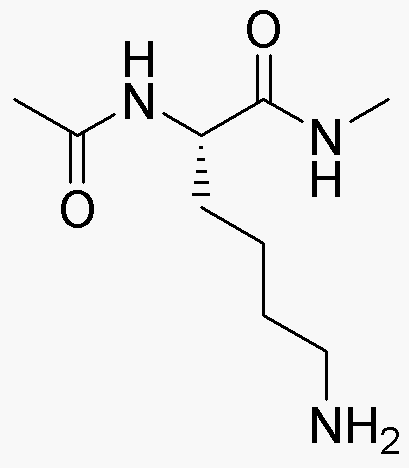Na-Acetyl-L-lysine methyl amide is widely utilized in research focused on:
- Biochemical Research: This compound serves as a valuable tool for studying protein acetylation, which is crucial in regulating gene expression and cellular functions.
- Pharmaceutical Development: It is explored in drug formulation for its potential to enhance the bioavailability of therapeutic agents, particularly in treatments targeting metabolic disorders.
- Nutrition Science: Researchers investigate its role as a dietary supplement, particularly in enhancing muscle recovery and performance in athletes.
- Cosmetic Industry: The compound is used in skincare formulations for its moisturizing properties and potential to improve skin texture and elasticity.
- Neuroscience: It is studied for its neuroprotective properties, with potential applications in developing treatments for neurodegenerative diseases.
General Information
Properties
Safety and Regulations
Applications
Na-Acetyl-L-lysine methyl amide is widely utilized in research focused on:
- Biochemical Research: This compound serves as a valuable tool for studying protein acetylation, which is crucial in regulating gene expression and cellular functions.
- Pharmaceutical Development: It is explored in drug formulation for its potential to enhance the bioavailability of therapeutic agents, particularly in treatments targeting metabolic disorders.
- Nutrition Science: Researchers investigate its role as a dietary supplement, particularly in enhancing muscle recovery and performance in athletes.
- Cosmetic Industry: The compound is used in skincare formulations for its moisturizing properties and potential to improve skin texture and elasticity.
- Neuroscience: It is studied for its neuroprotective properties, with potential applications in developing treatments for neurodegenerative diseases.
Documents
Safety Data Sheets (SDS)
The SDS provides comprehensive safety information on handling, storage, and disposal of the product.
Product Specification (PS)
The PS provides a comprehensive breakdown of the product’s properties, including chemical composition, physical state, purity, and storage requirements. It also details acceptable quality ranges and the product's intended applications.
Certificates of Analysis (COA)
Search for Certificates of Analysis (COA) by entering the products Lot Number. Lot and Batch Numbers can be found on a product’s label following the words ‘Lot’ or ‘Batch’.
Número de catálogo
Número de lote/lote
Certificates Of Origin (COO)
This COO confirms the country where the product was manufactured, and also details the materials and components used in it and whether it is derived from natural, synthetic, or other specific sources. This certificate may be required for customs, trade, and regulatory compliance.
Número de catálogo
Número de lote/lote
Safety Data Sheets (SDS)
The SDS provides comprehensive safety information on handling, storage, and disposal of the product.
DownloadProduct Specification (PS)
The PS provides a comprehensive breakdown of the product’s properties, including chemical composition, physical state, purity, and storage requirements. It also details acceptable quality ranges and the product's intended applications.
DownloadCertificates of Analysis (COA)
Search for Certificates of Analysis (COA) by entering the products Lot Number. Lot and Batch Numbers can be found on a product’s label following the words ‘Lot’ or ‘Batch’.
Número de catálogo
Número de lote/lote
Certificates Of Origin (COO)
This COO confirms the country where the product was manufactured, and also details the materials and components used in it and whether it is derived from natural, synthetic, or other specific sources. This certificate may be required for customs, trade, and regulatory compliance.


